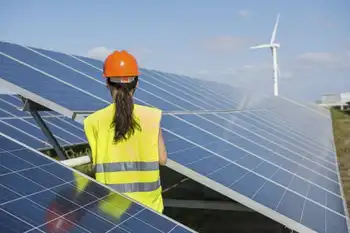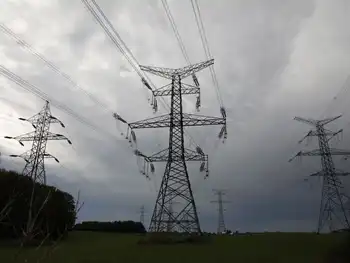PG&E drops local wave power plans
By Ft. Bragg Advocate-News
Protective Relay Training - Basic
Our customized live online or in‑person group training can be delivered to your staff at your location.

- Live Online
- 12 hours Instructor-led
- Group Training Available
Instead, the utility will continue WaveConnect only off Eureka, having claimed both areas with simultaneous Federal Energy Regulatory Commission, or FERC, permits in February 2007.
PG&E is hanging on to its exclusive claim on Fort Bragg waters for now, but does plan to release that claim later.
The preliminary permit, which legally resembles a mining claim, is good through February 2010. Other corporations have expressed an interest in the claim.
In Sonoma County, the government itself claimed areas off its coast, on behalf of residents. Local governments have not taken any stance on this issue yet.
The utility told a Fort Bragg City Council subcommittee the decision was based on engineering analysis that determined that Noyo Harbor is inadequate to support a wave energy pilot project.
"SAIC (Science Applications International Corporation) surveyed the harbor in early April, spoke with the harbormaster and Coast Guard. Their conclusion was that the harbor is too narrow and shallow and lacks adequate room for maneuvering barges for equipment," according to statements made by PG&E representatives, recorded in subcommittee meeting notes from this week provided by Fort Bragg City Manager Linda Ruffing.
Locals told the utility exactly that back in 2006, when city councilmen Dan Gjerde and Dave Turner described the problems in detail and suggested PG&E might help improve the harbor as part of the process.
"In response to a question of why it took so long to reach this conclusion when it seemed apparent to a lot of folks early on, (local project manager Bill) Toman explained that PG&E has pursued this study in an integrated fashion. They didn't get funding from CPUC (California Public Utilities Commission) until the end of January 2009, then they hired a consultant team and moved quickly forward. The initial Noyo Harbor site visit was in early April," Ruffing's notes state.
PG&E, paired with an earlier consultant, actually held a meeting in Noyo Harbor in 2006, with selected members of the Fort Bragg community, which did not include the city or the newspaper.
Toman never mentioned to the group substantial local opposition to the process used by the Federal Energy Regulatory Commission, which granted exclusive preliminary permits. Local fishers, environmentalists and public agencies have teamed up to reform the process and express concerns about environmental issues.
The City of Fort Bragg and Mendocino County, denied official status in the project by FERC, threatened lawsuits and filed lengthy federal appeals, with the county winning intervener status in the end.
There has been much less attention and participation in Eureka, according to those active in both places.
A substantial number of locals have come to oppose all wave energy over the last three years. Most, however, were frustrated by PG&E communications and FERC's overall process.
The Obama Administration ended a long-standing feud between the federal Minerals Management Service and FERC, giving FERC domain over wave energy inside three miles and creating a collaborative process in federal waters (more than three miles from shore).
Although FERC has a new direction under President Obama, there have been indications that the independent federal agency still isn't talking to state, much less local, government.
At a meeting in San Francisco run by Interior Secretary Ken Salazar last month, Peter Douglas, head of the California Coastal Commission, praised the working relationship with Interior but said, "We still hope to develop a relationship with FERC."
The City of Fort Bragg and local fishermen were caught by surprise when PG&E got its permit, thinking they would have been included beforehand. The City Council once became frustrated when PG&E representatives came to a city meeting to update the city with no new information. Gjerde said he didn't want any more updates unless there was actual new information provided.
PG&E has not utilitized the normal press release process locally, instead providing oral reports to different groups which often resulted in confusion.
PG&E did something this week they have been criticized for not doing throughout the four-year local process; provide extensive details.
"The wood docks and piers are not reinforced. There is no existing heavy lift capable of lifting 100-ton equipment. They would need approximately 50 acres of land onshore to support the operations. Noyo Harbor cannot support the testing of equipment," Ruffing's notes said.
"Humboldt Bay has a bigger harbor, more industrial uses and support facilities. PG&E has four power plants in the Eureka area (one is under construction, three will be decommissioned)," Ruffing's' notes said.
The Humboldt project too has been downsized from big expectations of 2006. The Humboldt WaveConnect project will take place on 200 acres of the 128 square miles claimed there. The utility has now decided to pursue a small, 5-year pilot project there, fully inside state waters.
"In the Humboldt WaveConnect project, PG&E is pursuing permits for a 5 megawatt facility. In March 2010, they will file a draft license application with FERC for a pilot license," Ruffing's notes said.
PG&E has garnered substantial grants from the U.S. Department of Energy and the California Public Utilities Commission for WaveConnect. Now that half the project is gone and the Humboldt portion downsized, it is unclear what the grant money will be used for.
"PG&E has $6 million in funding to pursue the WaveConnect project. It needs to be spent in support of the wave energy project study, permitting and outreach. Toman indicated that their short-term focus will be on the Humboldt project and that PG&E will eventually surrender their preliminary permit for the Mendocino WaveConnect project," Ruffing wrote.
In the California Public Utilities Commission proceedings, the Department of Ratepayer Advocate said wave energy was too nascent a technology for ratepayer funding. The grant money would end up enriching consultants, not the energy future of the nation.
PG&E is also planning a new, thousand-mile-long power cable along the Oregon coast that will extend into Northern California, where coastal power grids have long been neglected, creating lengthy blackouts and angst against PG&E by some.
Toman told the city group that PG&E has been contacted by Sonoma County regarding a partnership for a Department of Energy grant for their three wave energy applications.
"PG&E is the presumed interconnector utility for those projects. He indicated that PG&E would like to cooperate with Sonoma County. They have intervener status on the applications," Ruffing's notes said.
David Eisenhauer, spokesman for PG&E, said the meeting planned for May 21, 6 to 8:30 p.m. at Portuguese Hall in Fort Bragg will still be held, despite the PG&E withdrawal.
Ruffing's notes describe how PG&E will unveil its wave energy study in Humboldt County:
"Toman noted that the Humboldt WaveConnect project will test three to four technologies. PG&E will hold a worldwide solicitation in the next couple of months. This will involve first requesting information, then issuance of a formal request for proposals.
Once they have selected three or four tenants, they will fine tune design of host facility.
He noted that Finavera is no longer in the wave energy business, but they continue to hold all rights to their technology. Pelamis' (partners) are in bankruptcy. Ocean Power Technology, OceanLinks and all of the Wave Hub tenants would be in the running for a WaveConnect tenancy," Ruffing's notes said.
Humboldt State University will be a partner in the Humboldt WaveConnect project.
"PG&E plans to use their faculty and staff, particularly marine biologists and oceanographers, to perform studies and develop databases of information. They have not negotiated contracts, but he estimated that they may be in the $100K-$200K range," Ruffing's notes state.











